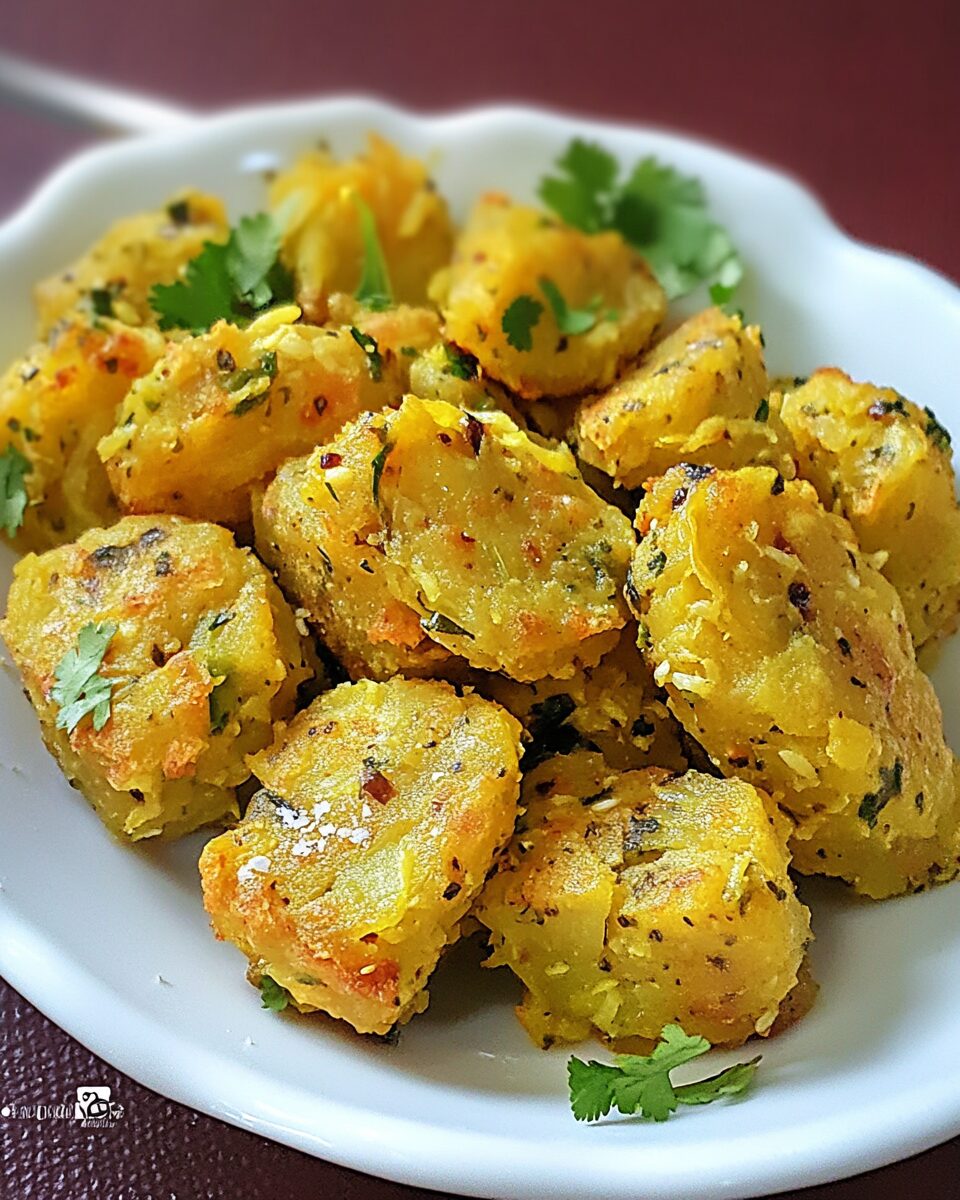The humble yet flavorful Cabbage Muthia is a beloved Gujarati snack that blends nutrition and tradition into one delicious bite. Made by mixing shredded cabbage with whole wheat flour, gram flour, and warm Indian spices, these steamed delights are perfect for guilt-free snacking. The soft, pillowy texture inside contrasts beautifully with the light crispness from a quick pan-fry in mustard-sesame tempering. Cabbage Muthia is not only easy to prepare but also versatile and forgiving a great way to use up extra cabbage while introducing a powerhouse of fiber and protein into your meal. Serve them with green chutney or enjoy them plain with a cup of masala chai. Whether you’re new to Indian cooking or a lifelong fan of Gujarati flavors, this snack will earn a permanent spot in your kitchen rotation.
Full Recipe:
Ingredients:
-
2 cups finely shredded cabbage
-
1 cup whole wheat flour
-
1/2 cup gram flour (besan)
-
1 tablespoon semolina (optional)
-
1 tablespoon ginger-green chili paste
-
1/2 teaspoon turmeric powder
-
1 teaspoon cumin-coriander powder
-
1/2 teaspoon asafoetida (hing)
-
1/2 teaspoon baking soda
-
1 tablespoon lemon juice
-
1 tablespoon sugar
-
Salt to taste
-
2 tablespoons chopped coriander leaves
-
1 tablespoon oil (for dough)
-
Water as needed
Tempering (optional but recommended):
-
1 tablespoon oil
-
1 teaspoon mustard seeds
-
1 teaspoon sesame seeds
-
A few curry leaves
-
Fresh coriander and grated coconut for garnish
Directions:
-
In a large mixing bowl, combine cabbage, wheat flour, gram flour, semolina, ginger-chili paste, turmeric, cumin-coriander powder, asafoetida, baking soda, lemon juice, sugar, salt, coriander leaves, and 1 tablespoon oil.
-
Mix well and add water gradually to form a soft dough.
-
Divide the dough into portions and shape into cylindrical logs.
-
Steam the logs in a steamer or a covered pot for 20-25 minutes until firm and cooked through.
-
Let them cool slightly, then slice into 1/2-inch thick pieces.
-
For tempering, heat oil in a pan, add mustard seeds, sesame seeds, and curry leaves.
-
Once they splutter, add the sliced muthia and sauté lightly until golden and crisp.
-
Garnish with fresh coriander and grated coconut before serving.
Prep Time: 15 minutes | Cooking Time: 25 minutes | Total Time: 40 minutes
Kcal: 160 kcal | Servings: 4 servings
Cabbage Muthia – A Steamed Gujarati Delight for the Health-Conscious Soul
When it comes to traditional Indian snacks, few are as wholesome, flavorful, and deeply rooted in culture as Muthia. Originating in the western Indian state of Gujarat, Muthia is a steamed snack made using a variety of flours and vegetables, typically seasoned with regional spices and herbs. Among its many variants, Cabbage Muthia stands out for its health benefits, versatility, and ease of preparation. It is an ideal dish for those seeking a guilt-free, nutritious bite without compromising on flavor.
In this article, we’ll explore the origins, health benefits, variations, serving ideas, and cultural significance of Cabbage Muthia, wrapping up with why this humble dish deserves a place in your kitchen repertoire.
The Cultural Heritage of Muthia
The word Muthia is derived from the Gujarati term “muthi”, which means “fist” named for the traditional method of shaping the dough by hand. Muthia has long been a staple in Gujarati households, particularly in the Kathiawad and Saurashtra regions, where people have mastered the art of creating flavorful dishes using simple, readily available ingredients. This snack has survived generations, passed down from grandmothers to daughters as a cherished family recipe.
Muthia is more than a dish it’s a memory. For many, it evokes nostalgia of a bustling kitchen, the sound of mustard seeds spluttering in hot oil, and the warm aroma of steaming flour and spiced vegetables. It is a beautiful expression of how Indian cuisine uses minimal resources to create nourishing, memorable meals.
Why Cabbage?
Cabbage might not be the first vegetable that comes to mind when thinking of Indian snacks, but in a Muthia, it works magic. Cabbage adds volume, moisture, and a subtle sweetness that balances the earthy bitterness of gram flour (besan). It’s also incredibly nutritious rich in fiber, Vitamin K, Vitamin C, and antioxidants that support digestion, immunity, and heart health.
This makes Cabbage Muthia not just an everyday snack but also a smart addition to a well-balanced diet. Its low glycemic index and fiber content make it ideal for people managing blood sugar levels or aiming for weight control. Plus, the steaming method ensures that you’re avoiding excess oils, keeping the dish light yet satisfying.
A Snack That Fits Every Diet
One of the greatest advantages of Cabbage Muthia is how easily it fits into various dietary plans:
-
Vegan: It uses no animal products and can be fully vegan with the right tempering oil.
-
Low Fat: Unlike deep-fried snacks, this is steamed first and pan-fried only if you want that extra texture.
-
Gluten-Lite: While it contains whole wheat flour, it’s possible to substitute with gluten-free flours like oat or millet flour for a completely gluten-free option.
-
Diabetic-Friendly: Thanks to its fiber and low sugar content, it helps in maintaining blood sugar levels.
-
High-Fiber: The combination of cabbage, whole grains, and chickpea flour makes it excellent for digestive health.
The Art of Tempering – Flavoring the Muthia
The steamed version of Cabbage Muthia is delicious as-is, but the tempering (known as vaghar in Gujarati) takes it to a whole new level. Typically, this involves heating a small amount of oil and adding mustard seeds, sesame seeds, curry leaves, and sometimes a pinch of asafoetida. Once the seeds splutter, sliced Muthia is tossed in the aromatic oil, giving it a light, crisp edge and a nutty flavor.
This process not only enhances taste but also adds to the sensory experience crispy edges, nutty aroma, and a gorgeous golden-brown hue. It is a brilliant example of how Indian cooking transforms simplicity into indulgence.
Versatility: From Snack to Meal
Although traditionally served as a snack or breakfast item, Cabbage Muthia can easily adapt to various roles on your dining table:
-
Appetizer: Serve it with a trio of chutneys (mint, tamarind, and garlic) for a stunning starter.
-
Lunchbox Favorite: Muthia holds well and tastes great even when cold, making it perfect for kids’ and adults’ lunchboxes.
-
Side Dish: Pair it with kadhi (yogurt-based curry) or dal-rice for a wholesome Gujarati-style meal.
-
Light Dinner: Combine it with a bowl of warm soup or salad for a balanced, light evening meal.
-
Party Snack: Serve bite-sized muthia rounds with cocktail sticks for a unique finger food option.
The subtle spices and universal appeal make it easy to serve to both traditional eaters and international guests.
Regional Variations of Muthia
Gujarat offers many regional takes on Muthia, often changing the hero ingredient based on seasonal availability:
-
Dudhi (Bottle Gourd) Muthia: A popular variation using grated bottle gourd for a slightly more moist texture.
-
Methi (Fenugreek Leaves) Muthia: Known for its slightly bitter notes, balanced with jaggery or sugar.
-
Carrot or Spinach Muthia: Great ways to add color and nutrients.
-
Jowar/Bajra Muthia: Ideal for winter months, using millet flours for extra warmth and earthiness.
These variations prove how adaptable the Muthia base recipe is it welcomes creativity and experimentation while maintaining its identity.
Storage and Make-Ahead Tips
Cabbage Muthia is great for meal prep. Here’s how to make the most of it:
-
Refrigerate: Once steamed and cooled, Muthia can be stored in an airtight container in the fridge for up to 3–4 days.
-
Freeze: You can freeze the steamed logs and slice/fry them as needed. Wrap them tightly in cling film and store for up to 1 month.
-
Reheat: Warm them on a skillet with a light tempering or microwave them if you’re short on time.
This make-ahead feature makes Muthia an excellent choice for busy professionals, parents, or anyone wanting to avoid last-minute meal stress.
Advertisement
Pairings & Serving Suggestions
Pair your Cabbage Muthia with:
-
Chutneys: Green chutney made from coriander and mint, tamarind-date chutney, or a fiery garlic chutney.
-
Tea: A hot cup of masala chai or green tea enhances the experience.
-
Yogurt: Serve it with plain yogurt or raita to balance the spices.
-
Rice Dishes: Add it as a crunchy topping to khichdi or pulav.
Its versatile flavor means it works across meals and courses.
Conclusion:
Cabbage Muthia might look simple, but it embodies everything that makes Indian home cooking so beloved nutrient-dense ingredients, clever techniques, and bold flavors made with love. Whether you’re new to Gujarati cuisine or already a fan, this dish is worth trying for its health benefits and cultural richness alone.
It’s budget-friendly, customizable, and ideal for batch cooking. It fits into modern dietary trends without losing its traditional charm. And best of all, it brings people together around the stove, at the dining table, and in the kitchen through shared memories and tastes.

